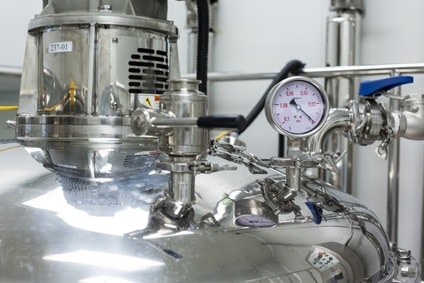The Complete Guide to Inspection Tags and Regulations for Boilers, Industrial Pressure Vessels, Valves & More


Inspection tags are useful tools that help to facilitate and ensure that proper inspection procedures are followed for equipment such as boilers, industrial pressure vessels, and valves. Inspection tags can be used to inform employees when inspection was last conducted on a part or piece of equipment, offering confidence that the equipment is in safe and working order.
Inspection tags can also indicate when a part or piece of equipment is scheduled for maintenance or repairs and can also be used to indicate the status of a current maintenance procedure that’s in-process. Finally, they can be used to communicate hazards and cautions in the workplace, such as denoting equipment that must be inspected prior to operation. And regular inspections aren’t only useful for safety; regular inspections, testing, and repair of leaking pressure safety valves, for instance, results in a cost savings for organizations, in addition to providing environmental benefits.
We’ve created this guide to provide a comprehensive understanding of inspection tags for boilers, industrial pressure vessels, valves, and other parts and equipment, outlining the information you need to know to ensure compliance with inspection requirements and appropriate equipment tags.
In this guide, we’ll discuss:
Regulations pertaining to the inspection and maintenance of equipment such as boilers, pressure relief valves, and industrial pressure vessels are largely issued on the state and local levels. However, some federal agencies have issued guidance and standards in an effort to guide state and local entities in creating appropriate regulatory requirements. These federal agencies include:
ASME issues standards on testing pressure relief devices and also offers accreditation for laboratories that test pressure relief devices. Additionally, ASME issues standards for the inspection, repair, and alteration of boilers as well as for various types of valves, such as flanged, threaded, and welding end valves. 
The National Board Inspection Code, first published in 1946 as a guide for chief inspectors, is now an internationally recognized standard that’s been widely adopted across many jurisdictions in both the United States and Canada. NBIC is organized in four parts, each related to specific post-construction activities related to pressure-retaining items, including:
The Pressure Relief Devices section is a new addition to the 2017 edition of NBIC, offering guidance on performing, verifying, and documenting the installation, inspection, and repair of pressure relief devices. Additionally, it includes information on pressure margins, recommended practices for repairing pressure relief devices, and details on test stand design.
The Unified Facilities Criteria (UFC), issued by the Department of Defense, offers guidance on the inspection and certification of boilers and unfired pressure vessels, covering the procedures necessary to determine the material condition of this equipment in order to ensure safe, reliable, and efficient operation. It also specifies the frequency of inspection and testing required, the specific items and components that must be tested or inspected, and the forms that must be used.
The National Board of Boiler and Pressure Vessel Inspectors outlines the specific steps required in order to prepare a boiler or pressure vessel for inspection, as well as specific tests and inspection activities to be carried out by inspectors. The American Petroleum Institute issues several standards related to the testing and inspection (and related topics) of pressure relief valves and other equipment, including API Standard 527, Seal Tightness of Pressure Relief Valves, API Standard 620: Design and Construction of Large, Welded, Low-pressure Storage Tanks, and API Standard 526: Flanged Steel Pressure Relief Valves, among others.
According to OSHA, most pressure and storage vessels in use in the United States are designed and constructed in accordance with either ASME Code (or Section VIII of the ASME “Boiler and Pressure Vessel Code”) or with API Standard 620, which establishes rules for lower pressure vessels which are not covered by the ASME Code. Certification of these vessels can only be performed by trained inspectors with the proper qualifications for each code, and certification requires written tests and practical experience.
In addition to having a thorough understanding of federal guidelines and recommendations, inspectors must be aware of all state and local regulations pertaining to inspecting and maintaining these items.
Pressure vessels must be certified during manufacturing and are required to be stamped with the proper codes issued by ASME. If a manufacturer is accredited by ASME for pressure vessels (under ASME Code Section VIII Div. 1), the manufacturer can stamp nameplates on vessels with the ASME “U” symbol.
Other pressure vessel stamps include U2, Alternative Rules Section VIII, Division 2 (Shop and /or Field) and U3, Manufacturing of High Pressure Vessels (Shop and /or Field). The “UV” symbol is designated by ASME for pressure relief valves. 
The use of these stamps on pressure vessel nameplates provides important information regarding the certification of manufacturers. When a customer orders a pressure vessel from a certified manufacturer and stamp holder, the customer does not need to enlist a third-party inspector for the vessel, as the vessel is already inspected by an Authorized Inspector (AI) who has signed the vessel’s data report. Authorized Inspectors must be certified by the NBIC.
Note that a Quality Control System must be implemented in accordance with the ASME code quality control manual, with procedures prepared by the manufacturer. Inspection-for-Industry.com offers a useful Inspection and Test Plan for pressure safety valves that can aid in this process. The quality control system (for pressure relief valves, industrial pressure vessels, and boilers, as well as other parts and equipment) should include ongoing inspection and testing plans and procedures – all of which must be documented over time on inspection tags and inspection and testing reports. The inspection procedure is distinct for each equipment type, involving several observations and tests, with each inspection culminating with recording and maintaining the inspection and testing results.
Inspection tags are designed for tracking inspection activities, providing equipment users with the added security of knowing that all parts and equipment have been inspected within an acceptable time frame and verified to be in safe, working order. Inspection tags should contain the following information:
Some inspection tags come pre-marked with months and years for inspection record tracking over a specified number of years, such as four years. These tags can also communicate the specific inspection requirements to employees (such as equipment operators) or to auditors.
The most common inspection tags, such as those used for fire extinguishers, are constructed of thick card stock. Some have areas for writing dates and other information (such as inspector identification numbers) on the tag, while others have tear-off portions that are used to indicate that an inspection has been performed. While this is suitable for some applications, industrial equipment often exposes tags to hazardous conditions that can render paper-based tags unreadable.
Anodized aluminum, such as Metalphoto® photosensitive anodized aluminum, offers superior durability compared to paper-based tags and is increasingly utilized for inspection tags for parts and equipment that operate in hazardous environments. Options such as re-writable metal labels are especially well-suited for inspection purposes, offering the ability to write information on the label, wipe it clean with isopropyl alcohol, and rewrite information on the label repeatedly, allowing for years of repeated use.
Alternatively, label blanks may be used, which allow users to utilize their own engraving, stamping, or label marking processes to document required information. Variable information tags are another option, which are useful for a variety of applications including equipment tags, service tags, compliance and inspection labels, and more.
In addition to inspection tags intended for documenting the performance of periodic inspections and repairs, most equipment requiring inspections also requires the use of compliance tags for the permanent documentation of important processes or procedures, such as operating or maintenance instructions, inspection procedures, and other essential information. Compliance tags are also printed with the equipment manufacturer, serial or model number, date of manufacture, load rating, or electrical specifications, all of which is essential information for performing equipment inspections. Instructional labels are a similar option, documenting equipment maintenance requirements, operating instructions, or safety instructions.
Other inspection tag materials include vinyl, nylon, stainless steel, and some plastics. When selecting an inspection tag for equipment and parts such as industrial pressure vessels, valves, and boilers, consider the operating environment of the equipment and choose inspection tags constructed of durable materials that can withstand these conditions throughout the life of the asset – or at least for the duration of the tag’s usable life (e.g., four years for inspection tags with pre-printed dates designed to track inspections over a four-year period).
You should also consider the process and procedures your company has in place when equipment fails to pass inspection or repairs or maintenance are needed before the equipment can be operated safely. There are tags designed specifically for these uses, printed on red or yellow card stock to indicate that the equipment is awaiting repairs or maintenance and should not be operated until post-repair or post-maintenance inspection confirms that it can be operated safely.

Some testing procedures must be carried out in highly controlled environments, meaning the equipment must be taken out of service until testing is complete. Have procedures in place and appropriate signage and tags on hand to address such scenarios.
Additionally, consider the frequency requirements for inspections. Generally, parts and equipment with greater hazard potential require more frequent inspections, meaning boilers, industrial pressure vessels, and valves will require more frequent inspection and testing than other equipment that poses less risk to operators (or is less subject to malfunctions with slight changes in operating conditions). Inspection frequency also depends on factors such as service, which can alter the ideal inspection frequency even for parts that have a broadly accepted, general guideline of “at least every five years.” For this reason, inspection frequency should be established on an individual basis, within the context of manufacturer requirements and an analysis of the actual service the part or equipment is in.
You’ll also want to think about the types of inspections required. For example, pressure systems are subject to both external and internal inspections. You’ll need appropriate inspection tags for documenting the completion of both types of inspections, as well as a means to differentiate inspection types – in other words, it may not make sense to document both inspection types on the same tag without some clear indicator of which type of inspection was performed.
As an example, the SLAC National Accelerator Laboratory notes the following minimum inspection intervals for pressure systems in a December 2015 report, denoting both internal and external minimum inspection intervals:
| Equipment Type | Inspection Type | Inspection Frequency |
| Heating boiler | External | 3 years |
| Pressure vessel, corrosive service | External and internal | 2 years |
| Pressure vessel, non-corrosive service | External | 3 years |
| Vacuum vessel | External | 5 years |
For pressure relief devices, the following minimum inspection frequencies are noted:
| Equipment Type | Inspection Frequency |
| Heating boiler | 3 years |
| Pressure vessel, corrosive service | 2 years |
| Pressure vessel, non-corrosive service | 3 years |
| Vacuum vessel | 5 years |
Ideally, an inspection tag will serve its purpose over the course of several years or more. In other words, an inspection tag with little space for documenting inspections will have a short lifespan for a part or piece of equipment that requires monthly inspections – meaning you’ll have to invest in replacement tags more often compared to inspection tags with a capacity for four or five years of documentation.
 Documenting inspections requires more than simply noting the date an inspection was performed on an inspection tag. In most cases, full inspection reports must be submitted to the custodian, who maintains all inspection reports for a minimum of five years. The custodian also forwards copies of all inspection reports received to the pressure systems program manager, who in turn adds the reports to the Pressure Systems Database. The same is true for all completed reports on repairs and maintenance.
Documenting inspections requires more than simply noting the date an inspection was performed on an inspection tag. In most cases, full inspection reports must be submitted to the custodian, who maintains all inspection reports for a minimum of five years. The custodian also forwards copies of all inspection reports received to the pressure systems program manager, who in turn adds the reports to the Pressure Systems Database. The same is true for all completed reports on repairs and maintenance.
The National Board Inspection Code offers several forms for reporting purposes:
In addition to standard inspection reporting forms, the NBIC offers a variety of forms for other purposes including:
Other forms include reports for repairs and alterations. The SLAC also provides a form for inspection reporting, as well as a form for reporting maintenance and repairs.
For more information on inspection regulations, standards, and inspection tags and other best practices, visit the following resources:
Inspection tags for boilers, industrial pressure vessels, and valves are just one component of overall quality control. To ensure regulatory compliance, inspection tags prove useful tools in ensuring that minimum inspection intervals are met and providing an audit trail of prior inspection and testing activities. Choosing the right inspection tags for your application will ensure that this vital documentation remains intact and readable throughout the lifespan of your assets.
Our sales engineers are experts in automatic asset tracking, tagging and identification,a nd can answer all your questions. Get in touch now.
Lets Talk ›